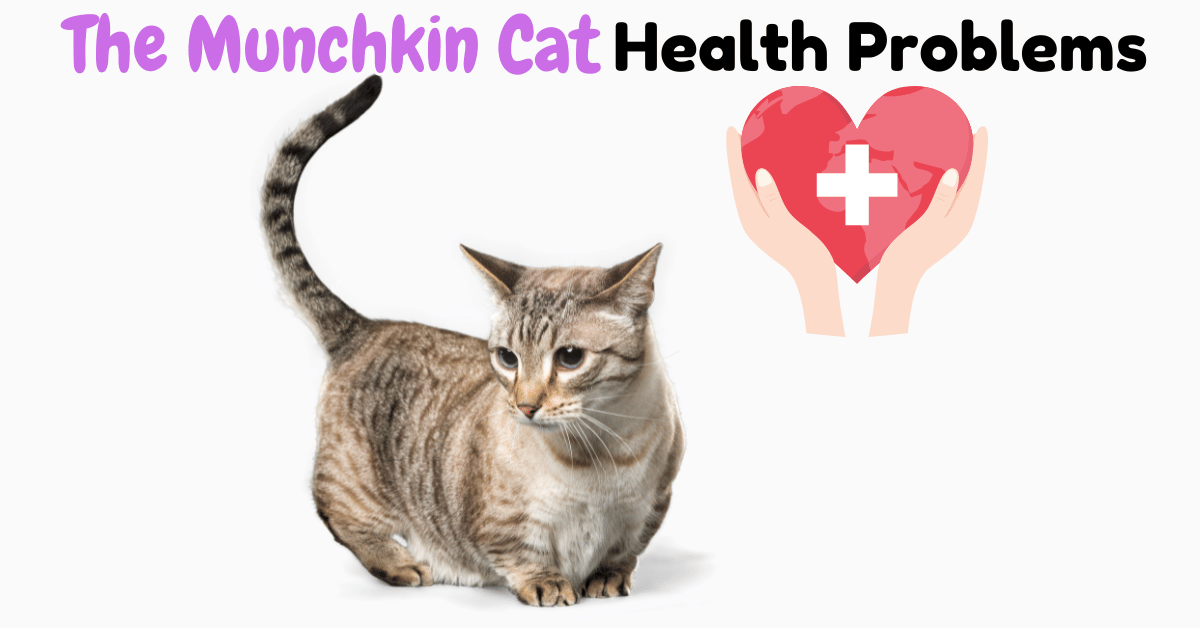This post contains affiliate links and I will be compensated if you make a purchase after clicking on my links.
Exploring Common Munchkin Cat Health Problems
While many health concerns like hyperthyroidism, progressive retinal atrophy, and feline lower urinary tract disease are common across various cat breeds, Munchkin cats face additional unique challenges, particularly in their musculoskeletal system.
These pint-sized felines typically have lifespans similar to those of other domestic cats, ranging from 12 to 15 years. Generally, they maintain an active lifestyle which helps keep their weight in check.
However, their short legs, a result of a form of disproportionate dwarfism known as chondrodysplasia, place additional strain on their spines. This mutation affects how their limb bones grow, leading to a compact but disproportionate body structure.
This guide zeroes in on the specific health issues predominantly seen in Munchkins and their derivative breeds, aiming to enlighten owners about proactive and informed care for these uniquely structured cats.
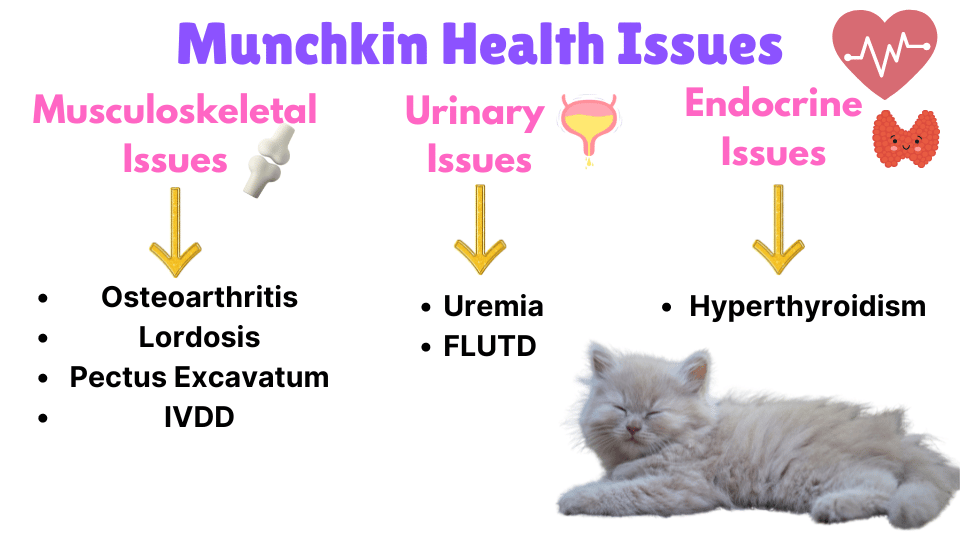
Fun Fact: While Munchkin cats might look like dwarf dog breeds like Dachshunds or Corgis, their genetics tell a different story. Munchkins have a unique mutation in the UDP-glucose 6-dehydrogenase (UGDH) gene, unlike the FGF4 mutation in those dogs. This means health issues common in dwarf dogs don’t necessarily affect Munchkins.
Musculoskeletal Health Issues in Munchkin Cats
1. Osteoarthritis
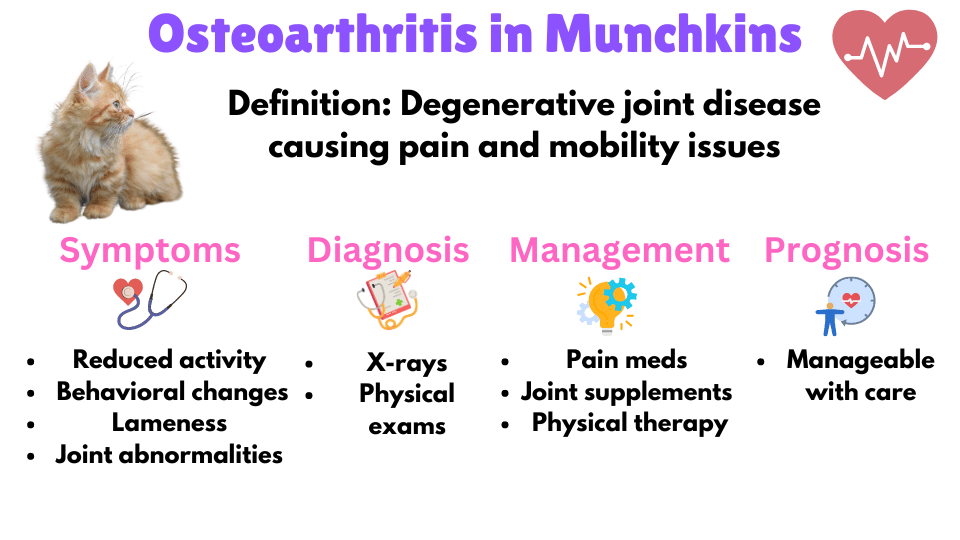
Osteoarthritis in Munchkin cats is primarily caused by the unique challenges posed by their skeletal structure. Due to their form of dwarfism, these cats have shortened limbs that lead to abnormal stresses on their joints, hastening the typical wear and tear on the joint cartilage. This cartilage is crucial as it cushions the joints during movement, protecting the bones from direct impact.
While all Munchkins exhibit some degree of limb deformity, the condition can significantly impair mobility in some individuals, particularly as they age. This makes them more prone to osteoarthritis compared to many other breeds, highlighting the need for vigilant care and preventive measures to manage their joint health.
Symptoms of Osteoarthritis
- Reduced Activity & Reluctance to Move: Decreased enthusiasm for playing or jumping, often accompanied by limping or an uneven gait.
- Behavioral Changes: Signs of discomfort may include increased irritability, decreased social interaction, and changes in temperament.
- Progressive Mobility Issues: Early stages might go unnoticed but can lead to more apparent lameness and pain during movement as the condition worsens.
- Joint Abnormalities: Ongoing breakdown of joint cartilage may result in abnormal bone growth and a thickening of the joint capsule, further impacting mobility and comfort.
Diagnosis of Osteoarthritis
This condition is primarily diagnosed through physical examinations and imaging techniques like X-rays, which can help identify the degenerative changes in the joints.
Management of Osteoarthritis
While there is no cure for osteoarthritis, effective management focuses on alleviating pain and maintaining mobility. Treatment may include pain relief medications, joint supplements such as TRI-ACTA, and tailored physical therapy sessions to enhance joint function without overstressing them.
Prognosis of Osteoarthritis
With diligent management and proper treatment, many cats with arthritis, including Munchkins, can lead normal, comfortable lives for several years. Early detection plays a crucial role in this outcome. However, severe cases may lead to a loss of quality of life, necessitating tough choices for pet owners. The goal in managing osteoarthritis is to ensure that Munchkin cats can enjoy life with minimal discomfort.
Tip: Osteoarthritis is a common ailment that affects many older cats across various breeds, but it can also present in younger Munchkin cats. Due to their unique physical structure, Munchkins may experience the effects of this joint disease earlier in life.
2. Lordosis
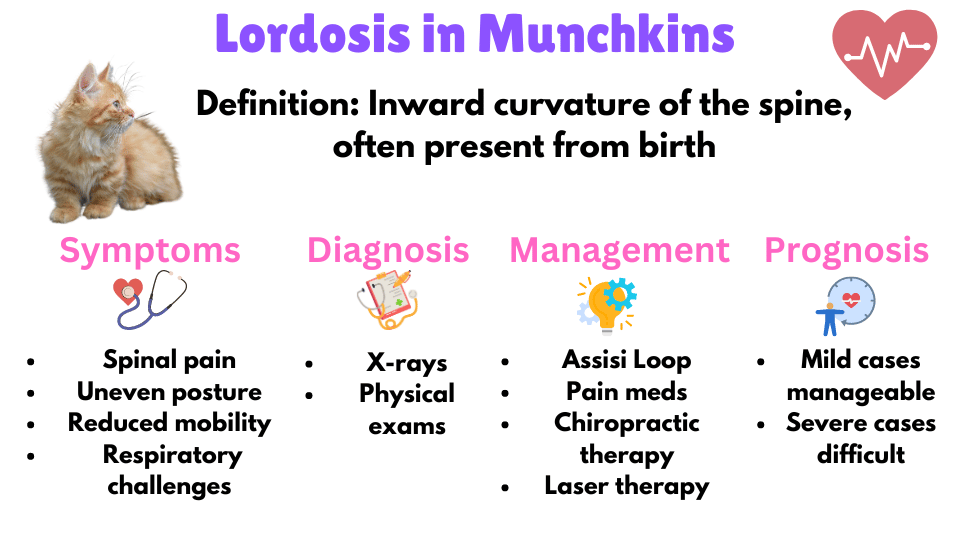
Lordosis refers to an abnormal inward curvature of the spine, typically observed in the lower back. This condition is congenital, meaning it’s present from birth, and is particularly noted in cats like Munchkins whose spine muscles may be too short. The severity of the curve can vary, from barely noticeable to severe enough to impact vital functions such as breathing, and in extreme cases, can affect the heart and lungs due to compression.
Symptoms of Lordosis
- Spinal Pain: Discomfort along the spine is common.
- Uneven Posture: Affected cats might lean to one side.
- Reduced Mobility: There may be a noticeable decline in how much the cat moves or plays.
- Respiratory Challenges: In severe cases, breathing difficulties can occur due to the curvature pressing on respiratory structures.
Diagnosis of Lordosis
Veterinarians may notice the characteristic curvature of the spine or observe the kitten displaying symptoms like difficulty in movement or breathing. Imaging studies such as X-rays can confirm the diagnosis and help assess the severity of the spinal curvature.
Management of Lordosis
Managing lordosis in Munchkin cats focuses on easing symptoms and improving their daily comfort, as the structural issues inherent to the condition cannot be fully corrected. The care plan typically includes innovative and supportive treatments:
- The Assisi Loop: This non-invasive device is a safe and easy way for pet parents to help reduce pain and inflammation. It can be used several times a day at home, making it a convenient part of daily care.
- Pain Management: Pain relievers and anti-inflammatory medications can help manage discomfort.
- Chiropractic or Manual Therapy: These therapies can be very beneficial, offering pain relief and helping the spine to move more freely, enhancing overall mobility and comfort.
- Laser Therapy: Known for reducing pain and inflammation, laser therapy is a powerful tool that complements other treatments like the Assisi Loop. It’s a recommended addition to the therapeutic regimen for its synergistic effects.
Prognosis for Lordosis
The prognosis for cats with lordosis depends on the severity of the condition. Mild cases may not significantly impact the cat’s lifespan or quality of life, and these cats can live relatively normal lives with appropriate care.
However, severe cases, especially those affecting the cat’s ability to breathe or causing significant pain, can lead to a poorer quality of life and may require difficult decisions regarding euthanasia to prevent suffering.
3. Pectus Excavatum
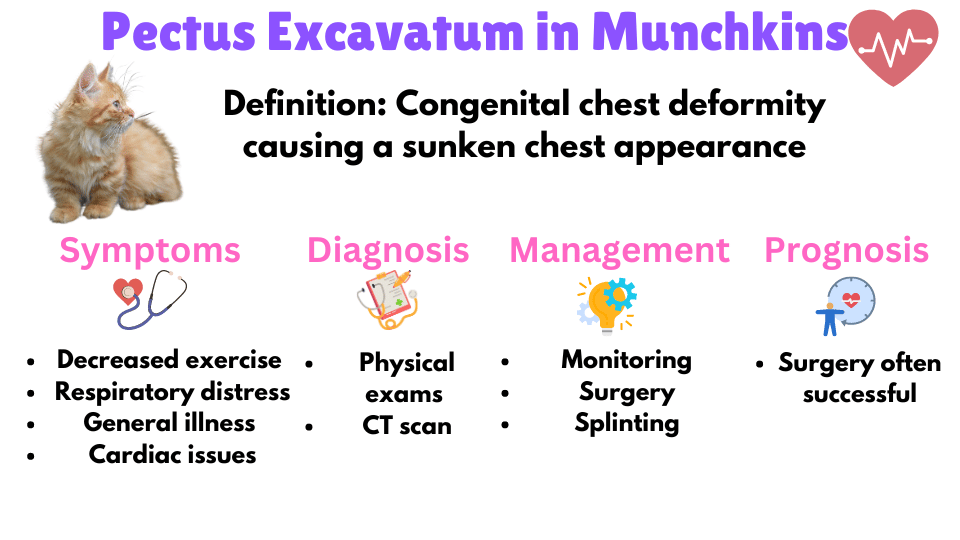
Pectus Excavatum, often referred to as funnel chest, is a congenital defect evident when the last few ribs and sternum of a kitten do not develop normally, resulting in a noticeably hollowed-out chest appearance. This condition typically becomes apparent when Munchkin kittens are around 10 days old but can manifest later as well. The structural deformity can cause the chest to compress the heart, leading to potential cardiac and respiratory issues.
Symptoms of Pectus Excavatum
- Decreased Exercise Tolerance: Kittens may show less interest or ability in physical activity.
- Respiratory Distress: Symptoms like coughing, difficulty breathing, and frequent upper respiratory infections can occur.
- General Discomfort and Illness: Signs include lethargy, poor appetite, weight loss or failure to thrive, and a visibly caved-in chest.
- Cardiac Issues: Tachycardia, or rapid heart rate, may be present due to the compression of the heart.
Diagnosis of Pectus Excavatum
Diagnosing Pectus Excavatum typically involves a physical examination where the deformity can be visibly noted. For a more detailed assessment, X-rays and a CT scan may be performed to evaluate the extent of the deformity and its impact on the heart and lungs. This helps in planning the appropriate treatment strategy.
Management of Pectus Excavatum
- Monitoring: Mild cases might require regular monitoring to assess any progression or impact on the kitten’s health.
- Splinting: Applying a splint to the ribcage is another treatment option that can help in reshaping the chest wall as the kitten grows.
Prognosis for Pectus Excavatum
The prognosis for kittens with Pectus Excavatum largely depends on the severity of the condition. Munchkin cats with mild forms may experience little to no impact on their overall health, while those with more severe forms benefit greatly from early surgical intervention.
Post-surgery, most cats recover well and go on to lead healthy lives, although close monitoring and follow-up care are essential to ensure optimal recovery and growth.
4. Intervertebral Disc Disease (IVDD)
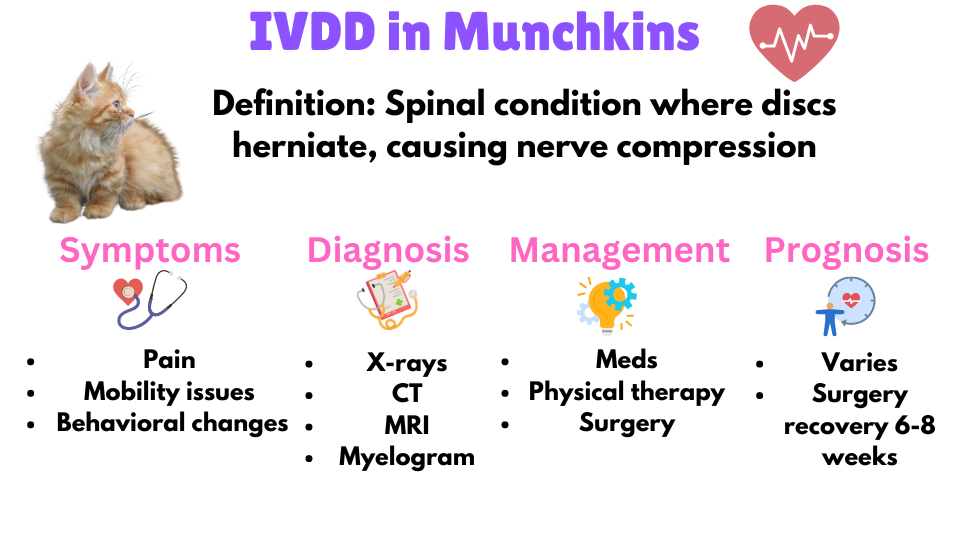
Intervertebral Disc Disease, or IVDD, is a serious condition where changes within the spine lead to the herniation or protrusion of the discs between the vertebrae. This can compress spinal nerves, causing significant pain, potential nerve damage, and in severe cases, paralysis. Although IVDD is rare in cats, Munchkin cats, with their unique skeletal structure featuring elongated and sometimes malformed spines, are at a heightened risk.
Symptoms of IVDD
- Pain and Discomfort: Obvious signs include vocalizing when moved or touched, reluctance to jump or climb, and hunched posture.
- Mobility Issues: Affected cats may show changes in gait, stiffness, or even partial paralysis.
- Behavioral Changes: Increased irritability, decreased activity, or changes in normal routines may be noted due to pain.
Diagnosis of IVDD
Diagnosing Intervertebral Disc Disease (IVDD) involves a thorough physical examination by a veterinarian, including palpating the cat’s back for pain, checking proprioception by flipping the cat’s paws, and assessing gait through a video. This is often complemented by advanced imaging studies such as X-rays, CT scans, or MRIs to pinpoint the exact location and severity of the disc herniation.
Additionally, a myelogram may be performed by inserting a needle into the dural sac surrounding the spinal cord and administering a colored dye.
Management of IVDD
- Medication: Mild cases can often be managed with anti-inflammatory drugs, pain relievers, and possibly steroids to reduce swelling and pain.
- Physical Therapy: Regular sessions can help maintain mobility and prevent muscle atrophy in affected cats.
- Surgical Intervention: In severe cases where conservative treatments fail to provide relief or if there is significant neurological impairment, surgical intervention may be necessary to remove the pressure on the spinal cord and stabilize the spine.
Prognosis for IVDD
The prognosis for IVDD in cats varies based on the severity of the condition and the timeliness of intervention. Cats with mild to moderate IVDD often respond well to medical management and can maintain a good quality of life with proper care.
However, if your cat undergoes surgery, they’ll need to spend a couple of days in the hospital to recover. When it’s time for them to come home, you’ll receive specific instructions on how to restrict their activity and manage their pain.
Expect the recovery process for a surgically corrected slipped disc to take about six to eight weeks. During this time, keeping your cat calm and comfortable is key to a successful healing process.
Urinary System Issues in Munchkin Cats
5. Uremia
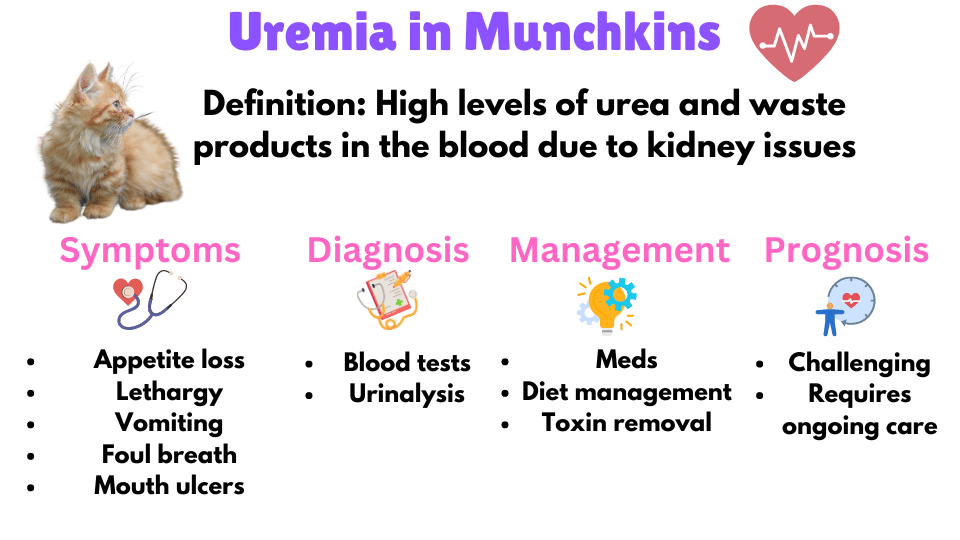
Uremia is a serious condition characterized by high levels of urea and other waste products in your cat’s bloodstream. Normally, these by-products are filtered out through the kidneys and excreted in urine. However, due to various issues like kidney damage, kidney stones, exposure to toxins, or inflammation, these toxins can accumulate in the blood, leading to uremia.
Symptoms of Uremia
- Appetite Loss: Your cat may show less interest in food or stop eating altogether.
- Lethargy: A noticeable decrease in energy and activity levels.
- Vomiting: Frequent vomiting can be a sign of the body trying to expel toxins.
- Foul-Smelling Breath: An unusual or bad breath odor due to toxin buildup.
- Mouth Ulcers: Sores in the mouth, making it painful for your cat to eat or drink.
Diagnosis of Uremia
Diagnosing uremia typically involves a thorough examination by your vet, who will run blood tests to check levels of waste products like urea, proteins, and amino acids. A white blood cell count and urinalysis are also common to assess kidney function and identify any underlying causes.
Management of Uremia
The treatment for uremia hinges on identifying and addressing the underlying cause. If kidney function is compromised, your vet may prescribe medications to alleviate symptoms and support kidney health, while emphasizing the management of diet and fluid intake to stabilize the condition.
For uremia caused by toxic substances, the initial step involves removing toxins from the body, potentially through gastric lavage or the use of activated charcoal to neutralize toxins. In cases where the toxic agent is identified, specific antidotes may be administered.
Medications such as diuretics, antiemetics, dopamine derivatives, mucosal protectants, and bicarbonates might also be prescribed to support these efforts and manage the symptoms effectively.
Prognosis for Uremia
Uremia typically has a challenging prognosis, with potential complications including seizures, coma, high blood pressure, pneumonia, bleeding in the digestive tract, cardiac arrest, fluid overload, widespread infection, and multiple organ failure.
The cost of treating acute uremia can be substantial, often involving intensive interventions like dialysis until the cat is stable enough for further treatment. Post-treatment, it’s crucial to monitor daily fluid levels, mineral balances, body weight, urine output, and overall physical condition. The recovery process varies greatly based on the extent of organ damage, the disease’s origin, and any co-existing health conditions.
6. Feline Lower Urinary Tract Disease (FLUTD)
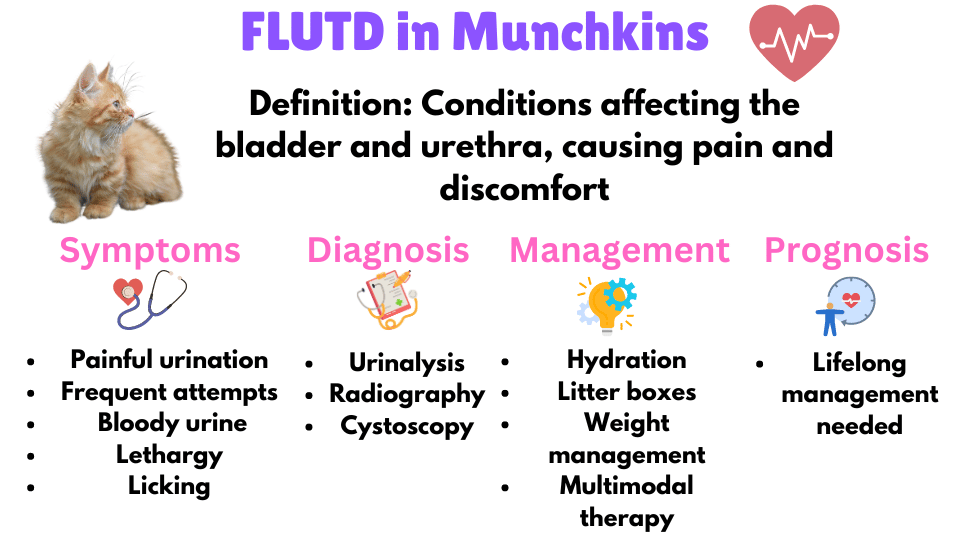
Feline Lower Urinary Tract Disease (FLUTD) encompasses a variety of conditions affecting the bladder and urethra, including bladder stones, cystitis, and urinary blockages. These issues can cause significant pain and discomfort for Munchkin cats during urination.
Symptoms of FLUTD
- Painful Urination: Cats may vocalize or appear strained while trying to urinate.
- Frequent Attempts to Urinate: Often, only a small amount of urine is passed or none at all.
- Bloody Urine: This may be seen if inflammation or infection is present.
- Lethargy: General discomfort may reduce your cat’s activity levels.
- Licking Urinary Opening: Due to irritation, cats frequently lick at their urinary opening.
Diagnosis of FLUTD
Diagnosing Feline Lower Urinary Tract Disease (FLUTD) can be quite the detective work because the condition has many potential causes, making its origin tricky to pinpoint. To ensure a thorough diagnosis, a systematic approach is essential. At a minimum, every cat showing signs of FLUTD should undergo a complete urinalysis with sediment examination and survey abdominal radiography. The diagnosis often involves ruling out other potential causes of the symptoms.
Additionally, a detailed examination of the inside of the urethra and bladder using a special device called a cystoscope is commonly employed to get a clearer picture of the underlying issues.
Management of FLUTD
- Increase Hydration: Encourage more water intake by offering wet food and using water fountains.
- Multiple Litter Boxes: Provide additional litter box options for convenience.
- Weight Management: Help overweight cats shed some pounds.
- Multimodal Therapy: Combine various therapies for comprehensive treatment.
- Emergency Care: Seek immediate veterinary help if your cat cannot urinate.
- Medication: Administer medications as needed to relieve pain, treat infections, or dissolve crystals.
Prognosis for FLUTD
The prognosis for cats with FLUTD depends largely on the specific cause and how quickly treatment begins. While many cats recover with proper management, some may experience recurrent episodes, requiring ongoing dietary and lifestyle adjustments. Though symptoms can improve within days, FLUTD often comes back, making active, lifelong management essential.
In severe cases, long-term medication might be needed, and cats responding well to prescription diets should stay on them indefinitely. While many cats with FLUTD can live long, happy lives, there are instances where treatment fails, and euthanasia might be considered for those whose pain and anxiety cannot be controlled.
Endocrine System Issues in Munchkin Cats
7. Hyperthyroidism
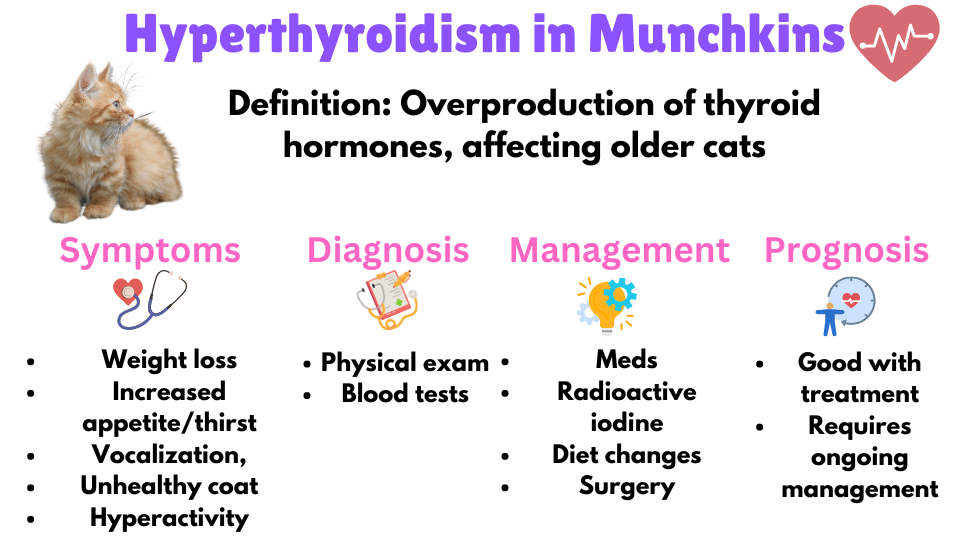
Hyperthyroidism in cats occurs when the thyroid gland produces an excessive amount of thyroid hormones. This condition is most commonly seen in older cats and can significantly impact their overall health and behavior.
Symptoms of Hyperthyroidism
- Weight Loss: Despite a voracious appetite, your cat might start shedding pounds.
- Increased Appetite and Thirst: You’ll notice your cat eating and drinking more than usual.
- Increased Vocalization: A hyperactive thyroid can lead to increased meowing and restlessness.
- Unhealthy Coat: Your cat’s fur might become unkempt and less shiny.
- Vomiting: Frequent vomiting can be a sign of this condition.
- Hyperactivity: Your feline friend may appear unusually energetic or agitated.
Diagnosis of Hyperthyroidism
To diagnose hyperthyroidism, your vet will start with a thorough physical examination, including palpating the neck area to check for an enlarged thyroid gland. The vet will also assess the cat’s heart rate and blood pressure.
If a thyroid issue is suspected, your veterinarian will conduct a blood chemistry panel and analyze thyroid hormone levels. These tests are crucial to confirm the condition and rule out other potential causes of the symptoms. Most cats with hyperthyroidism have elevated levels of the thyroid hormone T4 in their bloodstream, though a small percentage may have T4 levels within the normal range.
Management of Hyperthyroidism
- Medication: Antithyroid drugs can help control hormone production and manage symptoms effectively.
- Radioactive Iodine Therapy: This treatment destroys overactive thyroid tissue, often providing a permanent solution.
- Dietary Changes: Specially formulated diets can help manage hormone levels.
- Surgery: In some cases, surgical removal of the thyroid gland may be recommended.
Prognosis for Hyperthyroidism
With proper treatment, many Munchkin cats with hyperthyroidism can lead normal, healthy lives. However, ongoing management and regular veterinary check-ups are essential to monitor the condition and adjust treatments as needed.
Conclusion: Navigating Munchkin Cat Health Problems
Munchkin cats, with their charmingly short legs and playful personalities, can face a variety of health challenges, much like other breeds with specific physical traits, such as brachycephalic cats. It’s crucial for owners to be aware of these potential problems and work closely with their veterinarians for regular check-ups and tailored treatment plans.
While many Munchkin cats can live normal, healthy lives with proper care, the ongoing scrutiny and understanding of their specific needs are vital. This is particularly important for trends towards cats with extremely short legs, such as “rug hugger” Munchkins, until studies can definitively confirm the long-term health impacts of these mutations.
Meet Sean, a fintech whiz with a penchant for pet purrs and blockchain buzz. After a decade of fintech feats, Sean’s tech talents leaped from ledger lines to litter lines, driven by a passion for pets and a vision for a more connected pet care community. With three critter companions as co-pilots, Sean launched this blog to share a treasury of pet-friendly tech tips and tales.

